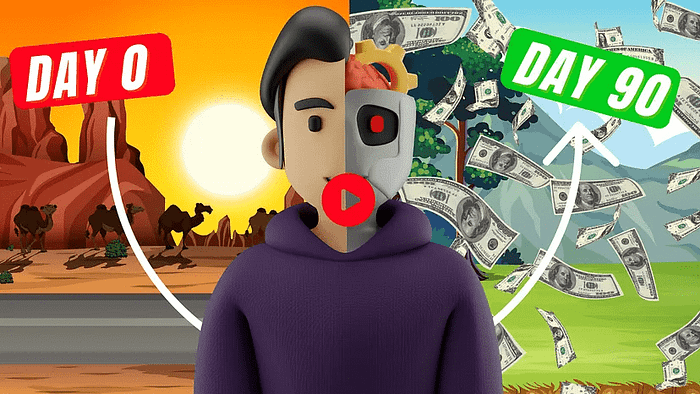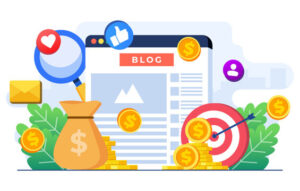10 Engagement-Driving Blogging Tips for Building a Loyal Audience
Blogging tips can transform your online presence from a mere collection of posts into a vibrant, engaging platform that keeps readers coming back for more.
When you start a blog, your main goal is to attract readers and keep them interested in your content.
However, building a loyal audience requires more than just writing great posts.
It’s about creating a connection with your readers, understanding their needs, and consistently delivering value.
This article will explore ten powerful blogging tips that can help you drive engagement and build a loyal following.
By implementing these strategies, you’ll be able to turn casual visitors into devoted fans who eagerly await your next post.
So, let’s dive into the world of engagement-driven blogging and discover how you can create a thriving community around your content.
We strongly recommend that you check out our guide on how to take advantage of AI in today’s passive income economy.
Table of Contents
1. Know Your Audience Inside and Out
Understanding Your Readers’ Needs and Preferences
One of the most crucial blogging tips for building engagement is to truly understand your audience.
This means going beyond basic demographics and delving into their interests, pain points, and motivations.
Start by creating detailed reader personas that represent your ideal audience members.
These personas should include information about their age, occupation, hobbies, challenges, and goals.
Use tools like Google Analytics and social media insights to gather data about your current readers.
Pay attention to which posts get the most engagement and try to understand why they resonate with your audience.
Conduct surveys or polls to directly ask your readers what topics they’re most interested in and what problems they’re trying to solve.
By deeply understanding your audience, you can tailor your content to meet their specific needs and interests.
Crafting Content That Speaks Directly to Your Readers
Once you have a clear picture of your audience, use this knowledge to create content that speaks directly to them.
Address their specific challenges and offer practical solutions they can implement in their lives.
Use language and examples that resonate with their experiences and interests.
For instance, if your blog is about personal finance and your audience is primarily young professionals, you might focus on topics like budgeting for city living or paying off student loans.
Incorporate stories and anecdotes that your readers can relate to, making your content more personal and engaging.
Remember to update your understanding of your audience regularly, as their needs and interests may change over time.
By consistently delivering content that feels tailor-made for your readers, you’ll keep them coming back for more.
2. Develop a Unique and Authentic Voice
Finding Your Blogging Personality
Among the most valuable blogging tips is to develop a unique and authentic voice that sets you apart from other bloggers in your niche.
Your voice is what makes your content distinctly yours and helps readers connect with you on a personal level.
Start by reflecting on your personality traits, values, and communication style.
Are you naturally humorous, serious, compassionate, or analytical?
Let these qualities shine through in your writing to create a genuine and relatable voice.
Experiment with different writing styles and tones to find what feels most natural and engaging for you.
Don’t be afraid to inject your personality into your posts, sharing personal anecdotes and opinions where appropriate.
Remember that authenticity is key – readers can often sense when a blogger is trying too hard or putting on a persona.
Consistency in Tone and Style
Once you’ve found your unique voice, it’s important to maintain consistency across all your blog posts and other content.
This consistency helps readers know what to expect from your blog and builds a sense of familiarity and trust.
Create a style guide for your blog that outlines your preferred tone, language use, and formatting choices.
This guide can include things like whether you use casual or formal language, how you structure your posts, and any particular phrases or catchphrases you like to use.
While consistency is important, don’t be afraid to evolve your voice over time as you grow as a blogger and your audience changes.
The key is to make any changes gradual and organic, rather than sudden shifts that might confuse or alienate your readers.
By developing and maintaining a unique, authentic voice, you’ll create a strong brand identity for your blog that resonates with your audience.
3. Create High-Quality, Value-Packed Content
Focusing on Depth and Usefulness
One of the most critical blogging tips for building a loyal audience is to consistently produce high-quality, value-packed content.
Your readers should feel that they’re gaining something valuable every time they visit your blog.
Focus on creating in-depth content that thoroughly explores a topic rather than surface-level articles that merely scratch the surface.
Research your topics extensively, drawing from reputable sources and your own experience or expertise.
Provide practical, actionable advice that your readers can implement in their lives or businesses.
Include real-life examples, case studies, or data to support your points and make your content more credible and useful.
Don’t be afraid to tackle complex topics – break them down into digestible chunks and explain concepts clearly.
Remember, your goal is to become a go-to resource in your niche, known for providing comprehensive and helpful information.
Balancing Different Content Types
While maintaining high quality, it’s also important to offer a variety of content types to keep your blog engaging and cater to different learning styles.
Mix up your content with how-to guides, listicles, opinion pieces, interviews with experts, and personal stories.
Consider incorporating visual elements like infographics, charts, or custom illustrations to break up text and convey information in different ways.
If you’re comfortable on camera, you might even add video content to complement your written posts.
Experiment with different post lengths – while in-depth, long-form content is great for SEO and providing comprehensive information, shorter posts can be useful for quick tips or news updates.
Regularly ask your audience for feedback on what types of content they find most valuable and adjust your content mix accordingly.
By consistently delivering high-quality, diverse content, you’ll keep your readers engaged and coming back for more.
4. Foster Two-Way Communication
Encouraging and Responding to Comments
One of the most effective blogging tips for building engagement is to foster two-way communication with your readers.
Encourage your audience to leave comments by ending your posts with thought-provoking questions or calls to action.
Make it easy for readers to comment by using a user-friendly comment system and minimizing barriers like required sign-ups.
When readers do comment, make sure to respond promptly and thoughtfully.
Address commenters by name and take the time to provide detailed, helpful responses to their questions or insights.
Even if a comment is just a simple compliment, acknowledge it with a thank you to show that you value your readers’ input.
Consider highlighting particularly insightful or interesting comments in future posts, giving credit to the commenter.
This not only rewards engagement but also shows other readers that their contributions are valued and may be featured.
Creating Opportunities for Reader Input
Go beyond just responding to comments by actively seeking out reader input and involvement in your blog.
Conduct polls or surveys to get your readers’ opinions on topics you’re writing about or to help decide what to cover next.
Create posts that specifically ask for reader experiences or advice on a particular topic.
Consider running a “Reader Spotlight” feature where you showcase a reader’s story or expertise related to your blog’s niche.
Host Q&A sessions where readers can submit questions for you to answer in a blog post or live video.
If appropriate for your niche, you might even invite guest posts from your most engaged readers, giving them a platform to share their knowledge.
By actively involving your readers in your blog, you’re not just creating content for them, but with them.
This level of interaction can significantly boost engagement and foster a strong sense of community around your blog.
5. Optimize for Search Engines Without Sacrificing Readability
Implementing SEO Best Practices
While engagement is crucial, it’s equally important to ensure that people can find your blog in the first place.
That’s where search engine optimization (SEO) comes in, and it’s one of the most important blogging tips to master.
Start by researching and using relevant keywords naturally throughout your content, including in titles, headings, and the first paragraph.
Use tools like Google Keyword Planner or SEMrush to find keywords that your audience is searching for.
Optimize your meta descriptions and title tags to make your posts more clickable in search results.
Ensure your blog has a clear, logical structure with appropriate use of header tags (H1, H2, H3, etc.).
Improve your site’s loading speed by optimizing images and using a reliable hosting service.
Build high-quality backlinks by creating shareable content and reaching out to other bloggers in your niche.
Remember to regularly update old posts with fresh information and internal links to keep them relevant and boost their SEO value.
Maintaining a Balance Between SEO and Readability
While SEO is important, it should never come at the expense of readability and user experience.
Your primary focus should always be on creating valuable, engaging content for your human readers.
Use keywords naturally and avoid keyword stuffing, which can make your content sound robotic and off-putting.
Break up your content into short, easy-to-read paragraphs and use subheadings to improve readability.
Include relevant images, infographics, or videos to make your content more engaging and easier to digest.
Use internal linking to guide readers to related content on your blog, but don’t overdo it – each link should add value.
Consider the user intent behind the keywords you’re targeting and ensure your content fully addresses the reader’s needs.
By striking the right balance between SEO and readability, you’ll not only attract more visitors through search engines but also keep them engaged once they arrive at your blog.
6. Consistency is Key: Develop a Posting Schedule
Creating and Sticking to a Content Calendar
One of the most underrated blogging tips is the power of consistency in building a loyal audience.
Develop a content calendar that outlines what you’ll post and when, planning at least a month in advance.
Consider your audience’s habits and preferences when deciding on the frequency and timing of your posts.
Be realistic about how often you can consistently produce high-quality content – it’s better to post less frequently but consistently than to start strong and then peter out.
Use tools like Google Calendar or project management software to organize your content schedule.
Plan for different types of content throughout the month to keep things interesting for your readers.
Include important dates or events relevant to your niche in your calendar to ensure timely content.
Be flexible enough to adjust your schedule for unexpected news or trending topics in your industry.
Managing Reader Expectations
Once you’ve established a posting schedule, communicate it clearly to your readers so they know when to expect new content.
Consider adding a “What’s Coming Up” section to your sidebar or newsletter to build anticipation for future posts.
If you need to deviate from your usual schedule, let your readers know in advance to manage their expectations.
Use social media or email newsletters to remind readers about new posts and maintain engagement between publishing dates.
Consider creating “filler” content like quick tips or curated content roundups for times when you can’t produce a full-length post.
Remember that consistency isn’t just about frequency – maintain a consistent quality level in your posts as well.
If you’re going through a busy period, it’s better to reduce your posting frequency temporarily than to publish subpar content.
By maintaining a consistent posting schedule, you’ll build trust with your audience and give them a reason to regularly return to your blog.
7. Leverage the Power of Social Media
Choosing the Right Platforms for Your Audience
Integrating social media into your blogging strategy is one of the most powerful blogging tips for expanding your reach and engaging with your audience.
Start by researching which social media platforms your target audience uses most frequently.
For example, if you’re targeting young professionals, LinkedIn and Twitter might be more effective than TikTok or Snapchat.
Don’t try to be active on every platform – focus on 2-3 where your audience is most engaged.
Tailor your content and approach to each platform’s unique features and user behavior.
For instance, Instagram is great for visual content, while Twitter is perfect for quick updates and engaging in industry conversations.
Consider creating platform-specific content in addition to sharing your blog posts to provide extra value to your social media followers.
Regularly review your social media analytics to understand which types of posts perform best on each platform and adjust your strategy accordingly.
Building a Community Around Your Blog
Use social media not just to promote your blog, but to build a community around it.
Engage with your followers by responding to comments, asking questions, and starting conversations.
Share behind-the-scenes content or personal insights to help your audience connect with you on a more personal level.
Create and use a unique hashtag for your blog to make it easy for followers to find and share your content.
Consider creating a Facebook group or Discord server where your most engaged readers can interact with each other and with you.
Run social media contests or challenges related to your blog content to boost engagement and attract new followers.
Use social listening tools to monitor mentions of your blog or relevant topics, and join these conversations when appropriate.
Remember that building a social media community takes time and consistent effort, but it can significantly boost your blog’s engagement and reach.
8. Incorporate Multimedia Elements
Enhancing Posts with Visual Content
One of the most effective blogging tips for increasing engagement is to incorporate a variety of multimedia elements into your posts.
Start by adding relevant, high-quality images to break up text and illustrate key points in your articles.
Create custom graphics or infographics to present data or complex information in an easily digestible format.
Use screenshots or step-by-step image tutorials when explaining processes or demonstrating how to use tools.
Consider creating branded images with quotes from your post that are easy for readers to share on social media.
Experiment with different types of visuals, such as charts, diagrams, or even memes, to see what resonates most with your audience.
Always optimize your images for web use to ensure fast loading times, which is crucial for both user experience and SEO.
Remember to use alt text for all images to improve accessibility and provide context for search engines.
Exploring Video and Audio Content
While written content is the foundation of most blogs, incorporating video and audio can significantly boost engagement.
Consider creating video versions of your blog posts for viewers who prefer visual learning.
Use short video clips to demonstrate techniques or showcase products that you’re discussing in your posts.
Start a podcast that complements your blog content, allowing you to dive deeper into topics and reach audiences in new ways.
Embed relevant YouTube videos (your own or others’) to provide additional context or perspectives on your topics.
Experiment with live streaming on platforms like YouTube or Facebook to engage with your audience in real-time.
If you’re not comfortable on camera, consider using animated explainer videos or screencasts to add visual elements to your content.
Remember to always provide transcripts or written summaries of your audio and video content to make it accessible to all users and to boost SEO.
By incorporating a variety of multimedia elements, you can cater to different learning styles and keep your content fresh and engaging.
9. Collaborate with Other Bloggers and Influencers
Building Mutually Beneficial Relationships
Collaboration is one of the most powerful blogging tips for expanding your reach and bringing fresh perspectives to your audience.
Start by identifying other bloggers or influencers in your niche who have a similar audience size or slightly larger.
Reach out with genuine compliments and engage with their content before proposing any collaboration.
Look for ways to provide value to potential collaborators, not just what you can gain from the relationship.
Consider starting with small collaborations, like guest posting or social media shoutouts, before proposing larger projects.
Be clear about your expectations and goals for any collaboration, and be open to hearing your partner’s ideas and needs.
Maintain professionalism throughout the collaboration process, from initial contact to project completion and follow-up.
Remember that building strong relationships takes time, so be patient and focus on long-term mutual benefits rather than quick gains.
Types of Collaborations to Consider
There are many ways to collaborate with other bloggers and influencers to drive engagement and grow your audience.
Guest posting is a classic collaboration method – write for each other’s blogs to cross-pollinate your audiences.
Co-create content like ebooks, webinars, or online courses that combine your expertise and expand both of your offerings.
Participate in or organize blog carnivals, where multiple bloggers write posts on a shared theme and cross-promote each other.
Interview other bloggers or experts in your field and feature them on your blog.
Collaborate on a podcast episode or video series, leveraging each other’s strengths and platforms.
Organize a group giveaway or contest with other bloggers in your niche to attract new followers and engage existing ones.
Consider creating a roundup post featuring insights from multiple influencers on a particular topic.
By collaborating with others in your niche, you can tap into new audiences, gain fresh perspectives, and create exciting content that drives engagement.
10. Continuously
10. Continuously Analyze and Adapt Your Strategy
Utilizing Analytics to Understand Your Audience
One of the most crucial blogging tips for long-term success is to continuously analyze your performance and adapt your strategy accordingly.
Set up Google Analytics or a similar tool to track key metrics like page views, time on site, and bounce rate.
Pay attention to which posts are performing well and try to understand why they’re resonating with your audience.
Use heat mapping tools to see how readers are interacting with your content and where they’re clicking.
Monitor your social media analytics to understand which platforms are driving the most traffic and engagement.
Look at your email newsletter metrics, such as open rates and click-through rates, to gauge the effectiveness of your email strategy.
Consider using A/B testing for elements like headlines, call-to-actions, and email subject lines to optimize your performance.
Remember that numbers only tell part of the story – combine quantitative data with qualitative feedback from your readers for a complete picture.
Adapting Your Blogging Strategy Based on Insights
Once you’ve gathered data and insights, use them to refine and improve your blogging strategy.
If certain types of posts consistently perform well, consider creating more content in a similar vein.
Adjust your content calendar based on when your analytics show your audience is most active and engaged.
Use insights from comments and social media interactions to generate ideas for new content that addresses your readers’ questions and interests.
If your bounce rate is high, consider improving your site navigation or internal linking strategy to keep readers on your site longer.
Experiment with different content formats or lengths based on what your analytics show is most engaging for your audience.
Regularly review and update your keyword strategy based on search trends and your posts’ performance in search results.
Don’t be afraid to pivot your strategy if the data suggests a new direction could be more effective.
By consistently analyzing your performance and adapting your approach, you can ensure your blog remains relevant and engaging to your audience.
Conclusion:
Implementing these ten blogging tips can significantly boost your engagement and help you build a loyal audience.
Remember that building a successful blog is a journey, not a destination.
It requires consistent effort, adaptability, and a willingness to learn and grow along with your audience.
Start by deeply understanding your readers and crafting content that speaks directly to their needs and interests.
Develop a unique voice that sets you apart and creates a strong connection with your audience.
Focus on creating high-quality, valuable content that keeps readers coming back for more.
Encourage two-way communication to foster a sense of community around your blog.
Optimize your content for search engines without sacrificing readability to ensure your posts reach a wider audience.
Maintain a consistent posting schedule to build trust and keep your readers engaged.
Leverage social media to expand your reach and interact with your audience beyond your blog.
Incorporate multimedia elements to make your content more engaging and accessible to different learning styles.
Collaborate with other bloggers and influencers to cross-pollinate audiences and bring fresh perspectives to your blog.
Finally, continuously analyze your performance and adapt your strategy to ensure your blog remains relevant and engaging.
By implementing these blogging tips, you’ll be well on your way to creating a thriving blog with a loyal, engaged audience.
Remember, building a successful blog takes time and patience, but with dedication and the right strategies, you can create a platform that not only attracts readers but keeps them coming back for more.
So start implementing these blogging tips today and watch your audience grow and engage with your content in new and exciting ways.

We strongly recommend that you check out our guide on how to take advantage of AI in today’s passive income economy.




